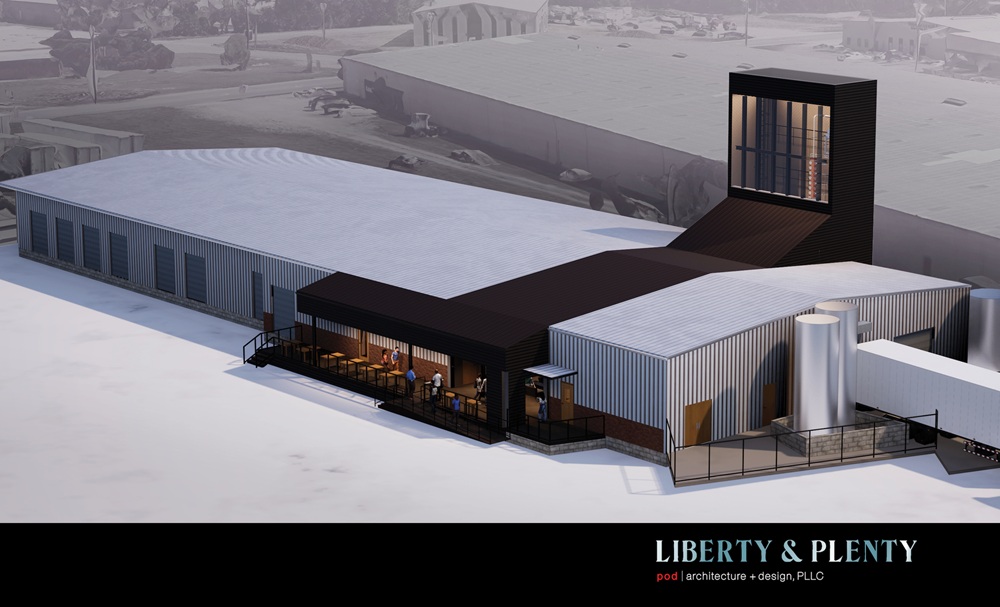Construction is underway on Liberty & Plenty Distillery in Wilson, NC, as pod architecture + design (pod) of Chapel Hill – the design studio behind Rabbit Hole Distillery in Louisville, KY -- works to repurpose an old, pre-engineered metal building (aka PEMB, aka Butler building) into what promises to be the second largest spirits distillery in the state.
The original Liberty & Plenty Distillery opened in 2020 in Durham, NC’s Central Park district. There, pod architecture + design’s founding partners and principal designers -- Doug Pierson, AIA, and experiential designer Youn Choi -- collaborated with owner and master distiller Tina Williford to convert a one-story, ca. 1938 brick tobacco warehouse into her first small-batch craft distillery fronted by an elegant indoor/outdoor cocktail bar.
The Noble Butler
Architect Doug Pierson believes repurposing a Butler “is a noble and delicate endeavor. Butler buildings are parsimonious by nature. They’re lightweight, simple structures with economy, not aesthetics, at the forefront.”
Choi agrees. “It takes an entrepreneur like Tina Williford, with her vision and her courage, to see the possibilities in both a 1938 tobacco warehouse and a repurposed Butler building.”
“It’s the ‘greenest’ and most cost-effective way to go,” Pierson said, adding, “Stonewall Structural Engineering played an integral role in figuring out how to modify the delicate structural system of the existing building cost-effectively and sensibly. We could not have gotten there without them.”
The building’s total usable square footage is 17,913. In 2023, Williford had 8,128 square feet carved out of the eastern half of the structure for barrel storage. That left pod’s partners with approximately 8000 square feet for the new distillery and 1,150 conditioned square feet for the Tasting Room inside, along with space for an outside patio and usable green space.
The Tasting Room and viewing area will be separated from the working distillery by full-height interior glazing. Black corrugated metal walls in the Tasting Room and corridor, warmed by modern millwork, will lend an “industrial chic” ambience to these public spaces.
Out of a Problem, a High-Performance Solution
The pod duo’s expertise in distillery design and sustainable architecture, combined with creative thinking and the counsel of Atlantec Engineers, provided the solution to a structural problem and ushered in a “new” sustainable design element:
To accommodate the height of the 45-foot-tall column still, Pierson and Choi inserted a modern “doghouse dormer” (named for its shape) into the metal building’s otherwise blank roof.
Traditionally, a doghouse dormer’s function is to provide natural light and ventilation inside a home or building. This industrial version will do much more than that. As Pierson explained, it will create a “stack” effect, trapping the heat that rises to the top of the structure. “In the summer, the warm air will be exhausted out,” he said, “and the resulting air stream will create a gentle indoor breeze, stratifying the air and leaving a cooler layer at the bottom where the people are. This system not only removes the hottest air, but it also circulates the cooler air through a natural convection current.”
In the winter, the opposite: “The heat that rises will be collected at the top and redistributed as ‘free heating’ via ducts and fans that we’re dedicating solely to this system.”
A third benefit: At 55 feet tall, clad in wood shiplap siding (repeated at the outdoor seating space), the doghouse will alter the overall form and identity of the once-nondescript Butler building in the town’s industrial district. Clad in translucent material, it will glow like a beacon at night.
Pierson and Choi are incorporating many environmentally sustainable strategies into the heart of the building’s otherwise energy-intensive use as a distillery. The doghouse dormer is one strategy. Another is “zero process waste.” Choi explained: “Under normal operating conditions, waste from the distillery process would be sent to the City of Wilson through sewer lines. At Tina’s distillery, process waste will be collected in outdoor tanks. From there, a local farmer will pick it up regularly and use it as feedstock for animals or as crop fertilizer depending on the raw material.”
Consultants/Engineers/Construction:
Structural Engineers: Stonewall Structural Engineering
Mechanical/Electrical/Plumbing/High-Pressure Steam Engineers: Atlantec Engineers/IMEG
Distillery Process Design: Boozewerks Consultants
Design/Build Tanks and Stills: Specific Engineering Solutions
Design/Build Silo's and Grain Distribution: Silverback Equipment Solutions
General Contractor: Ten Penny Construction

Media Contact
Company Name: Blue Plate PR
Contact Person: Kim Weiss
Email: Send Email
Country: United States
Website: https://www.podand.com





